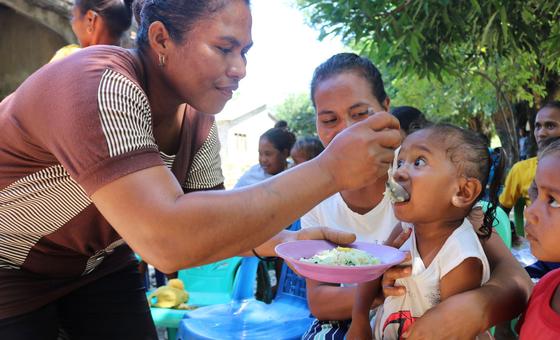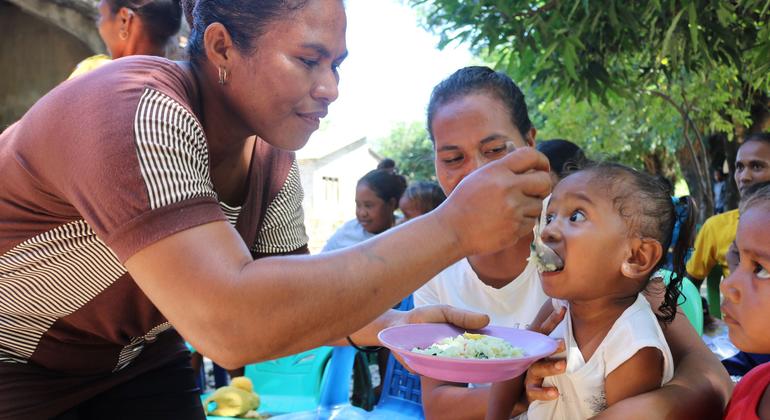
The huge central African nation has seen years of violence in the restive but resources-rich east, which have uprooted millions of people – some 2.7 million in North Kivu alone and more than seven million nationally.
“What breaks my heart is to see a population exhausted by violence, exhausted by conflict, exhausted by the horrors of their daily life”, Mr. Türk told journalists on Thursday in the capital Kinshasa.
“They need to have a future. They need to see a future. And we all need to work towards that.”
Mr. Türk noted that although the DRC “is one of the richest countries in the world” because of its immense natural resources, “this wealth is unfortunately not available to the population because there is violence”.
Over 25 million people need humanitarian help in the DRC and UN humanitarians have warned that epidemics are rampant – particularly cholera, with 50,000 suspected cases and 470 deaths in 2023, the worst since 2017.
Measles cases have more than doubled too, to over 320,000, with deaths tripling to over 6,000 last year.
UN continuing to reach thousands in Haiti with critical assistance
The UN and aid partners are continuing to reach hundreds of thousands of people with critical assistance, amid ongoing violence in the capital, Port-au-Prince.
The World Food Programme (WFP) reported their staff were able to reach more than 18,000 people with cash transfers on Wednesday and 210,000 children across the country received a school meal, said UN Spokesperson Stéphane Dujarric.
As part of the agency’s emergency response, food rations were distributed to about 8,000 people.
Gangs in the capital control from 80 to 90 per cent of the streets which has fuelled a socio-economic crisis stemming from years of political turmoil culminating in the recent resignation of Prime Minister Ariel Henry, who was forced out of office last month.
More than 360,000 have been displaced across Haiti and around 100,000 are living in temporary sites in deplorable conditions.
Unprecedented rights violations
Human rights chief Volker Türk said earlier this month the scale of violations “is unprecedented in Haiti’s modern history” with gangs attacking police station, prisons, public buildings and carrying out murders and kidnappings.
Sexual violence is pervasive and more than 5.5 million Haitians, mainly children, are dependent on aid. With around 44 per cent of the population food insecure, conditions are too dangerous to scale up assistance at scale.
Despite the ongoing crisis, WFP is managing to distribute hot meals to over 13,000 of those most in need across Port-au-Prince.
Runaway inflation, climate shocks, rising prices rock Timor Leste
A new report on food insecurity across Timor Leste released on Thursday reveals deteriorating levels of food insecurity in 12 of the Southeast Asian nation’s 14 municipalities.
The country is suffering through the highest inflation rate in a decade, successive climate shocks and soaring food prices.
An estimated 360,000 people, around one in four of the population, are grappling with crisis levels of food insecurity (IPC Phase 3 or above); of which 18,500 people are facing emergency conditions (IPC Phase 4), said WFP.
The situation is predicted to worsen from May to September during the post-harvest season, when food access normally improves.
“The 2024 Acute IPC Analysis provides the government with vital findings that will enable us to plan targeted support for communities in urgent need of food assistance, and to improve food security overall”, said Minister of Agriculture, Livestock, Fisheries and Forestry, Marcos da Cruz.
WFP Country Director and Representative for Timor-Leste Alba Cecilia Garzon Olivares said that with intensifying climate shocks and record inflation, the latest IPC Analysis makes it clear “urgent action is required now to avert a further deterioration in Timor-Leste’s food insecurity”.
“WFP remains committed to supporting the government and other partners in reversing this trend and strengthening nutrition-sensitive social protection systems.”
The IPC Analysis uses a set of internationally recognized tools and procedures to estimate the food insecurity situation in any given country. Check out our full explainer here.



